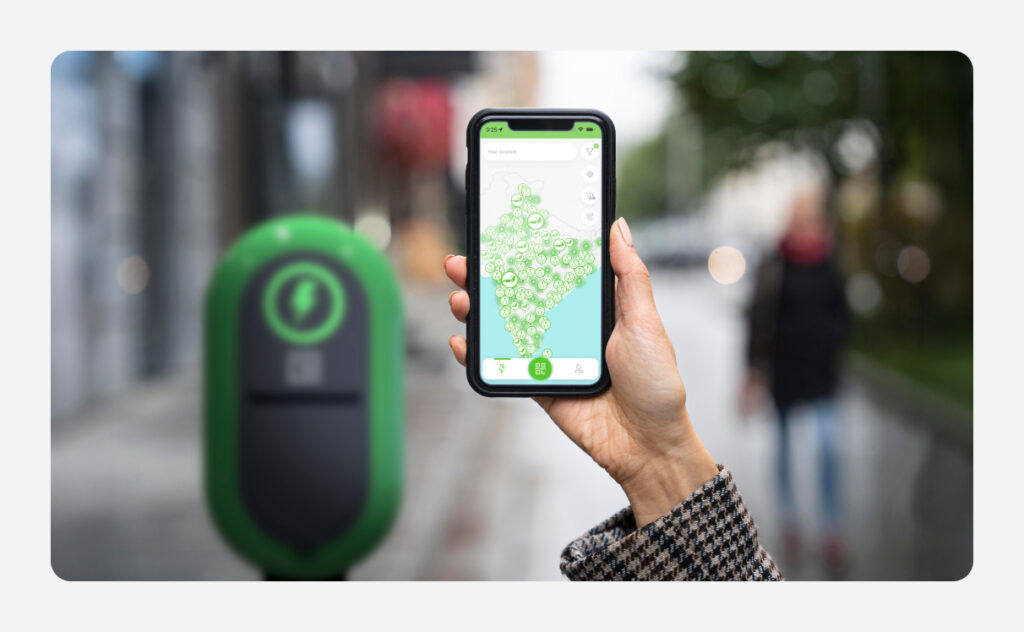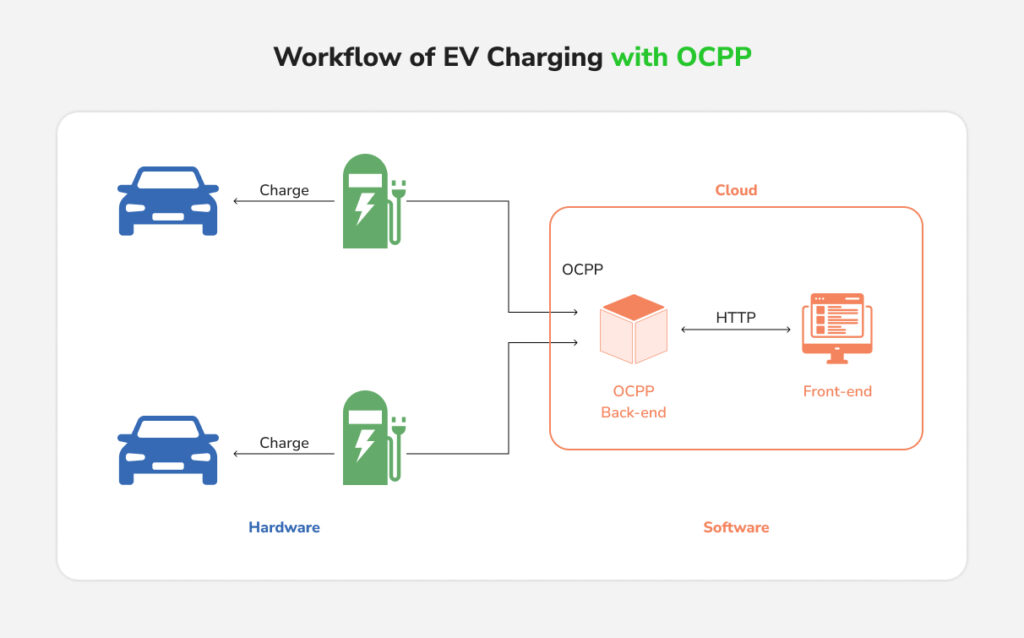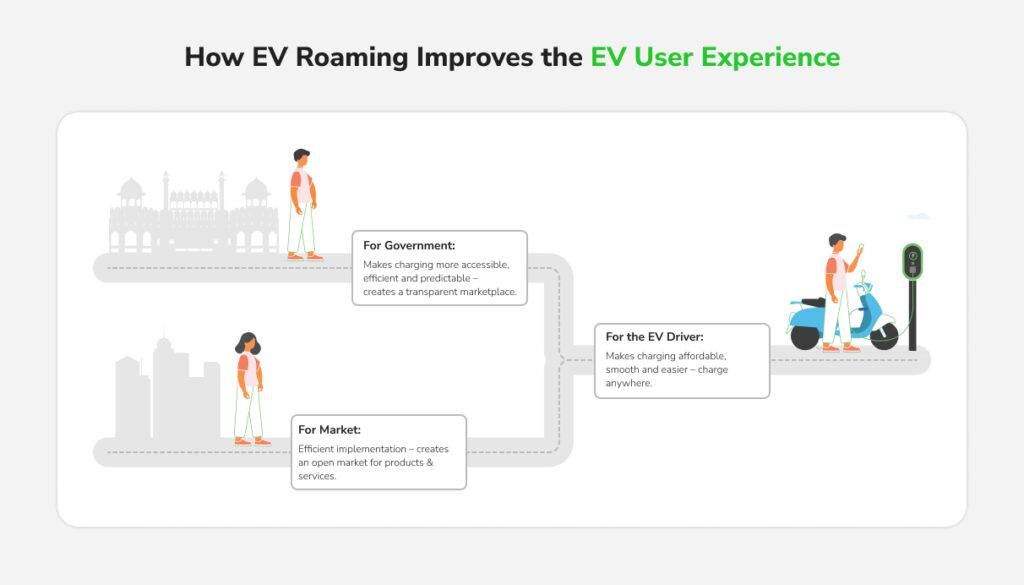EV Roaming in India: What It Means for Interoperability and User Experience
Raghav Bharadwaj
Chief Executive Officer
Published on:
17 Nov, 2025
Updated on:
24 Nov, 2025

With over 40 charge point operators (CPOs) running separate apps, logins, and payment systems, what should be a seamless charging experience often feels fragmented. An EV driver in Mumbai may need a different app in Delhi and yet another one on the highway.
EV roaming promises to change that. By letting drivers charge anywhere, on any network, using a single app or ID, it’s the missing piece that can make India’s charging ecosystem truly interoperable.
In this blog, we explore:
- What EV roaming is and how it works through open protocols like OCPP and OCPI.
- How roaming improves the EV user experience, from unified apps and payments to real-time discovery.
- What are the challenges of EV roaming, and how can industry and policy make “charge anywhere” a reality in India.
What Is EV Roaming?

EV roaming allows drivers to use chargers from multiple networks with a single account or app. For example, if you use Network A’s app, roaming lets you charge at a Network B or C station using the same login or RFID card. Behind the scenes, networks authenticate your account and handle billing automatically.
Roaming works either through direct partnerships between networks or via a central roaming hub, similar to how banks connect through a shared payment gateway. In both cases, it gives EV drivers seamless access to more chargers, shared real-time station data, and one consolidated bill or wallet.
Simply put, EV roaming makes charging network-agnostic. Much like how your phone connects to a partner network when you’re outside your carrier’s range, roaming ensures your EV can “charge anywhere” without the hassle of multiple apps. It’s a key step toward true interoperability.
India’s Fragmented EV Charging Landscape and the Need for Interoperability

India’s EV charging infrastructure has expanded rapidly, but in silos. Over 40 charge point operators (CPOs) run public charging networks, each with its own app, membership plan, and customer support. While competition has driven growth, it’s also created confusion. A driver might use one app in Mumbai, another in Bengaluru, and yet another on the highway. The result: too many apps, too many accounts, and a fractured user experience.
This fragmentation makes charging inconvenient and unpredictable. As one EV driver put it, “Why must I download 40 different apps to charge my EV?” Many users rely on third-party aggregators like PlugShare to locate chargers, only to switch apps again to start a session. Charging anxiety, wondering which app works where, has replaced range anxiety as the bigger concern.
For CPOs, isolation comes at a cost. A charger limited to one network can’t reach the full pool of drivers. Roaming changes that. When multiple CPOs joined an aggregation platform in 2023, some saw utilization jump from single digits to over 20% within weeks. Better usage means better revenue, stronger maintenance, and faster expansion, a virtuous cycle that benefits everyone.
In a country as vast as India, interoperability isn’t optional; it’s the key to making EV charging seamless and reliable.
Public vs. Private Charging Networks
Public networks are open to all EV users and form the backbone of India’s charging expansion; think stations in city lots, malls, highways, and fuel stations. Roaming between these networks allows drivers to plug in anywhere, no matter who operates the charger, making intercity travel and daily commutes far simpler. Public infrastructure has grown fast, from just over 5,000 stations in 2022 to around 26,000 by mid-2024.
Private networks include home, fleet, and workplace chargers that serve specific users. India already has a vast private base, Tata Motors alone has supported over 150,000 home installations. Though not open to the public, these chargers could eventually link into roaming systems under controlled conditions, such as apartment complexes offering limited access during off-peak hours, or homeowners sharing chargers through a peer-to-peer platform.
In the near term, roaming efforts in India are rightly focusing on public charging first, where fragmentation is currently a pain point. Over time, even private or semi-public chargers could be integrated selectively.
The Role of Open Protocols: OCPP and OCPI

How do different charging networks “talk” to each other to enable EV roaming? The answer lies in communication protocols. Two key ones drive global interoperability: OCPP and OCPI.
OCPP (Open Charge Point Protocol) connects charger hardware to the network’s backend software. It ensures any EV charger can communicate with any central management system, regardless of brand or manufacturer, as long as both support OCPP. India mandates OCPP compliance for all public chargers, mirroring policies in Europe and the US.

OCPI (Open Charge Point Interface) connects networks to networks. It governs how different CPOs and mobility service providers exchange data, authenticate roaming users, and settle payments.

OCPI is open-source and peer-to-peer, enabling large-scale cooperation without centralized control. In regions like Europe and California, OCPI 2.2 has become the de facto standard for EV roaming. India’s 2023 charging guidelines also highlight OCPI alongside OCPP as essential for open, interoperable networks that support unified payments and user access.
Together, OCPP and OCPI bridge every link, from the charger on the ground to the roaming platform in the cloud. OCPP ensures chargers can talk to their operators; OCPI ensures operators can talk to each other. This dual-layer interoperability turns isolated charging points into a connected national ecosystem.
India stands to gain immensely from adopting these open standards. Proprietary systems may promise short-term control, but they limit scale. By “speaking the same language,” every charger and every network can join a shared grid, reducing integration costs, expanding accessibility, and accelerating the country’s clean-mobility transition.
How EV Roaming Improves the EV User Experience

Ultimately, roaming is about making life easier for EV owners. A seamless roaming framework can improve the user experience in severalways:
1. One App, One Login
Roaming lets EV drivers replace dozens of apps, cards, and logins with a single account. Imagine opening one app, seeing every charger in India, regardless of operator, and starting a session instantly. No more switching between networks or managing multiple passwords. This simplicity removes the intimidation barrier for new EV owners.
2. Unified and Frictionless Payments
One wallet or monthly bill covers all your sessions across networks. Whether through UPI, cards, or a single prepaid balance, every station recognizes your payment credentials. Tap your RFID, scan a QR code, and charge, no recharging multiple wallets or struggling with failed gateways. India’s digital payment infrastructure makes this especially feasible, paving the way for consistent, reliable billing nationwide.
3. Smarter Discovery and Real-Time Accuracy
Real-time data shows charger status and pricing, improving route planning and making reservations smarter. Roaming expands options and builds trust through transparency.
4. Confidence Without Range Anxiety
With roaming, drivers know that any compatible charger will “just work.” No need to check which app or card applies. This reliability transforms EV ownership, especially for long-distance travel. It’s why in Europe, drivers barely think about who runs a station, they simply plug in and go. That’s the level of simplicity India must aim for.
5. One Point of Support
Roaming also simplifies customer service. If a session fails, users can contact their home provider, who will coordinate with the network in the background. Unified support lines, like those emerging under Tata’s verified charging program, make assistance consistent and stress-free. It fosters accountability and is convenient. When all networks share a connected system, persistent issues get noticed and fixed faster.
Challenges for EV Roaming in India
While the case for EV roaming is compelling, making it the norm in India is not without challenges. Both technical and commercial hurdles need to be overcome before “roam anywhere” truly becomes standard practice. Understanding these challenges is important in charting the path forward:
1. Industry Cooperation and Trust
Interoperability requires competitors to collaborate, which is often difficult. Large CPOs fear losing customer data or control; smaller ones worry about being undercut if bigger players use roaming data to identify prime charging spots. Reports already suggest such rivalries in India. Today, roaming often depends on bilateral agreements between networks and is slow, manual, and prone to “walled garden” behavior.
A neutral clearing body could help, similar to the NPCI (National Payments Corporation of India) in payments . Policy incentives or light mandates might also be needed to bring big networks to the same table.
2. Clearing and Settlement Systems
When a user charges on another network, payments require secure systems. Europe’s Hubject serves this role, but India doesn’t yet have an equivalent. However, India’s experience with UPI and FASTag proves that such interoperable, multi-party settlements are possible, the challenge is adapting that success to EV charging.
3. Technical Integration and Standards
Many chargers still lack support for open standards like OCPP 2.0 or OCPI 2.2. Smaller CPOs will need technical upgrades, vendor support, and cybersecurity reinforcement before joining roaming networks. The government has already mandated open protocols for new chargers; the next step is auditing and certifying older ones. Over time, standards like ISO 15118 (“Plug & Charge”) will make the user experience even simpler, but first, interoperability must be baked into every new deployment.
4. Commercial Models and Pricing
Roaming introduces fees, and aligning pricing is tricky. If charges are too high, users won’t adopt; too low, and CPOs lose incentive. A fair model should keep consumer tariffs consistent while letting networks share revenue transparently. Regulators may need to step in to prevent price discrimination between “home” and “roaming” users. CPOs, in turn, must shift their mindset from “owning customers” to serving the ecosystem, focusing on loyalty through experience, not exclusivity.
5. User Awareness and Behavior
Finally, it’s the human factor. Most EV drivers in India still rely on home or workplace charging and may not know roaming even exists. Likewise, on-ground staff might not recognize cross-network users. Awareness campaigns, unified apps, and clear on-screen confirmations can bridge this gap. Interoperability, after all, is as much about trust and familiarity as it’s about tech.
The Road Ahead for EV Roaming in India
Looking ahead, how can these challenges be addressed to make EV roaming standard in India? A few possible pathways emerge:

- Policy Mandate with Phased Targets: The government could set phased interoperability targets. For example, by 2025, all new public chargers must support OCPI-based roaming; by 2026, all major networks above a certain size must be part of a roaming arrangement (either via a hub or bilateral deals) or else face penalties/lose subsidies. This would push the industry to cooperate, much like NEVI did in the US.
- National Roaming Platform or Exchange: India might establish a national EV roaming exchange, possibly operated by a neutral entity like BEE or a consortium of CPOs, where all networks plug in and swap access. This could operate on a clearinghouse model. Given India’s strength in software, an indigenous platform could be developed to handle high volumes of micropayments and data securely. The Pulse Energy initiative could scale or be a foundation for such a hub, with support to bring all players on board.
- Customer-Centric Alliances: We may see the emergence of roaming alliances led by automotive OEMs or by new-age mobility service providers. If these alliances gain popularity with EV owners, CPOs will have market incentives to join to avoid losing traffic.
- Continuous Standardization and Innovation: India should continue aligning with global standards (OCPP, OCPI, ISO 15118) while also innovating for local needs. For example, integrating UPI as a payment mechanism in OCPI flows or using Aadhaar-based authentication for a unified EV owner ID could be local enhancements. Standardizing how user identification is done (perhaps via phone number or vehicle VIN in the backend) could simplify roaming agreements too.
Final Thoughts
Making EV roaming the norm in India is a journey that requires coordination between industry, government, and technology. The benefits for users and the EV sector are immense —convenience, confidence, and higher utilization —but getting there will take breaking down some silos and building new bridges. The current gaps are not insurmountable: India has addressed similar challenges in other domains (just as UPI transformed payments and telecom roaming simplified connectivity) .
With a combination of the right policy nudges, collaborative platforms, and continued pressure from an increasing EV owner base, EV roaming can become standard practice. In a few years, we should aim for an EV driver in India to be able to say, “I can charge anywhere, anytime, with one simple method, just like I can call anyone on any network or withdraw cash from any ATM.” That will be the true measure of interoperability and a key milestone in India’s e-mobility revolution.

Frequently Asked Questions
How does EV roaming actually work behind the scenes?
Roaming works through two communication layers:
- OCPP connects chargers to their home network.
- OCPI connects different networks to each other.
When you start a session on another network’s charger, OCPI handles authentication and billing, while OCPP manages charger operations. It’s similar to how mobile networks or ATM networks interoperate.
Why is EV roaming important for India right now?
Because India has 40+ CPOs, each with its own app and payment system. This fragmentation creates inconvenience and “charging anxiety.” Roaming:
- Makes charging predictable
- Increases charger utilization
- Creates uniformity in payments and support
Helps long-distance travel become stress-free
Is EV roaming only for public chargers?
Primarily yes, for now. But in the future:
- Apartment complexes may allow controlled public access
- Homeowners could offer peer-to-peer charging
Fleet or workplace chargers might open during off-peak hours
So private/semi-private chargers may join roaming networks selectively.
![Top EV Launches in India 2025: Cars, Scooters and 3-Wheelers [+Bolt.Earth Charger Compatibility]](https://bolt-wordpress.bolt.earth/wp-content/uploads/Top-EV-Launches-in-India-2025_-Cars-Scooters
-3-Wheelers-Bolt.Earth-Charger-Compatible.jpg)




